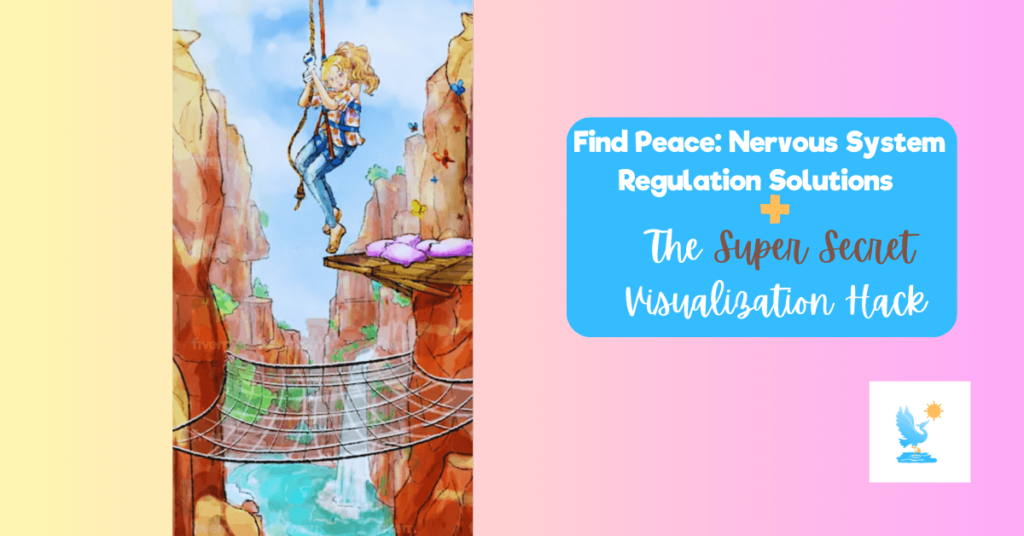Nervous System Regulation Explained: Triggers and Solutions

Nervous System Regulation Explained:
Common Disruptors and Solutions
Introduction
The nervous system is the body’s command center, orchestrating a symphony of functions that keep us balanced and thriving.
It is composed of the central nervous system (CNS), which includes the brain and spinal cord, and the peripheral nervous system (PNS), which connects the CNS to the rest of the body.
Within the PNS lies the autonomic nervous system (ANS), the key player in regulating vital, involuntary functions like heartbeat, digestion, and stress response.
The ANS has two branches:
Sympathetic Nervous System (SNS): Activates the fight-or-flight response, preparing the body to deal with stress.
Parasympathetic Nervous System (PNS): Facilitates rest, repair, and recovery—our calm and healing mode.
A healthy nervous system effortlessly shifts between these states, helping us respond to challenges and recover with ease.
When it’s functioning optimally, it supports
- smooth digestion,
- restorative sleep,
- and emotional resilience.
But when dysregulated with no way back to regulation, it can lead to
- chronic stress,
- burnout, or
- deeper health challenges.
Let’s explore what disrupts nervous system regulation and how to bring it back into balance.

What Disrupts Nervous System Regulation?
Our modern lifestyle is filled with factors that challenge the nervous system’s ability to maintain balance.
Here are the most common disruptors:
1. Chronic Stress: Relentless mental, emotional, or physical stress keeps the SNS on overdrive, leading to adrenal exhaustion, inflammation, and impaired recovery.
2. Environmental Toxins: Toxins are hidden saboteurs of nervous system health. Some of the most impactful include:
Heavy Metals: Mercury and aluminum, for example, can impair nerve communication and disrupt neurotransmitters.
Mold Exposure: Mycotoxins overstimulate the nervous system, creating a state of chronic stress and inflammation.
Parasites: These unwelcome guests can cause systemic inflammation, indirectly taxing the nervous system and impairing its regulation.
3. Emotional Trauma: Unresolved emotional wounds can trap the nervous system in survival mode, causing it to oscillate between hypervigilance (fight-or-flight) and shutdown (freeze response).
4. Poor Lifestyle Choices: Lack of quality sleep, inadequate movement, poor nutrition, and overexposure to screens disrupt the natural rhythms that support nervous system health.
Signs Your Nervous System Is Dysregulated
When the nervous system is out of balance, it sends signals through the body and mind.
These signs often feel like subtle whispers at first but can grow into louder alarms if ignored.
Let’s break it down:
Physical Symptoms:
Fatigue: A nervous system stuck in overdrive depletes your energy reserves, leaving you feeling tired even after a full night’s sleep.
Headaches: Chronic stress and tension can manifest as recurring headaches, often linked to tight neck and shoulder muscles.
Chronic Pain: Unresolved stress and trauma can lodge in the body, leading to ongoing pain that conventional methods struggle to address.
This could be joint aches, back pain, or even mysterious discomforts with no clear cause.
Emotional Symptoms:
Anxiety: A dysregulated system amplifies anxiety, fear and worries, making it hard to relax or feel safe in your body.
Mood Swings: Fluctuations in emotional states can occur because the nervous system struggles to stabilize between high alert (fight-or-flight) and shutdown (freeze).
Difficulty Focusing: Brain fog and a scattered mind often stem from a nervous system struggling to allocate resources efficiently.
This impacts productivity, creativity, and overall mental clarity.
By tuning into these signs, you gain awareness of your nervous system’s needs.
Instead of pushing through or numbing out, take these as cues to pause, reset, and address the root causes.
Your body is always speaking to you—the key is learning how to listen.

How to Bring Your Nervous System Back into Balance
Just as your nervous system can become dysregulated, it has an innate ability to heal and restore balance.
Here are evidence-based strategies and lifestyle practices to help.
1. Detoxification
Environmental toxins can be a significant burden on the nervous system.
- Heavy Metals: Consider detox strategies such as:
- Consider humic and fulvic acids in the bioactive carbon state.
- Open up drainage and support the pathways of detox and elimination
- Mold and Mycotoxins:
- Invest in air purifiers and remediate moldy environments.
- Use binders like modified citrus pectin or bio active carbon under professional guidance.
- Parasite Cleansing:
- Incorporate herbs like black walnut, clove, and wormwood into your routine.
- With specific guidance and a custom protocol you can help eliminate these nervous system stressors in the proper way. Contact me for guidance.
2. Stress Resilience
Counteract the effects of chronic stress with techniques that strengthen your parasympathetic nervous system.
- Breathwork: Practices like diaphragmatic breathing can quickly shift you into rest-and-digest mode.
- Mindfulness and Meditation: Consistent practice helps regulate your response to stressors. Check out the guided meditations section here.
- Yoga or Tai Ji: Movement-based therapies release stored tension and restore a sense of calm.
These practices help cultivate being in the moment.Out of the head and into the body and heart. This is where the magic happens.
3. Optimize Lifestyle Factors
Lifestyle plays a crucial role in nervous system regulation.
- Sleep Hygiene: Prioritize 7-9 hours of quality sleep. Limit screen time before bed and create a calming bedtime ritual.
If you are up in the night time invest in red lights so that your environment is free of blue light.Also disconnect wifi so you can sleep without this stressor on the nervous system.
- Nutrition:
- Include magnesium-rich foods like dark leafy greens and pumpkin seeds to soothe nerves.
- Omega-3 fatty acids from fish or flaxseed oil reduce inflammation and support brain health.
- Stay hydrated—dehydration can amplify stress responses.
- Include magnesium-rich foods like dark leafy greens and pumpkin seeds to soothe nerves.
- Movement: Regular exercise, even walking, supports nervous system flexibility and recovery.
4. Address Emotional Trauma
Unresolved trauma can keep your nervous system stuck in survival mode.
- Work with a somatic therapist or try trauma-informed approaches like EMDR or somatic experiencing.
- Journaling or expressive writing can also help release stored emotions.
5. Nervous System-Supportive Supplements
- Magnesium Glycinate: Helps relax muscles and calm the mind.
- Adaptogens: Herbs like ashwagandha and rhodiola support resilience under stress.
- L-Theanine: A calming amino acid that supports focus and relaxation.
- B Vitamins: Essential for neurotransmitter production and nervous system health.

6. The Visualization Hack: A Shortcut to Nervous System Safety
Whatever situation you’re in, there are several practices you can employ to help guide yourself back to safety in the moment.
Many experts teach about grounding into the now by focusing on your senses.
But for those of us who are visual, creating inner landscapes can be especially transformative to quickly shift back to safety.
This idea is inspired by the groundbreaking work of Deb Dana, who specializes in Polyvagal Theory and nervous system regulation.
Here’s a unique hack that uses a curated visualization to help you regulate your nervous system.
You can follow the image I’ve created for inspiration, then adapt it to your own inner world.
The Hack: Moving from Dysregulation to Safety
Imagine this scene:
You are climbing a cliff in a hasty manner, afraid of falling. This is an analogy of your dysregulation.
Below you, the drop-off feels vast and intimidating—it embodies being unregulated.
The chaos, fear, or uncertainty you feel mirrors the scene below.
But you’re not stuck here—there’s help.
On the cliff, you notice several tools:
- A Safe Platform: A secure spot nearby to take a break, rest, and find your footing.
- A Harness: This is your lifeline, offering steady support so you don’t feel overwhelmed or out of control.
- Knobs and Handholds: These represent the resources you can use to help you climb toward stability—small, actionable steps like deep breaths, self-affirmations, or reaching out for help.
Now, visualize a Special Light Tunnel that appears above the scene.
This tunnel is your gateway to regulation—a direct path to your safe haven.
All you have to do is say the words “Take me there.”
Instantly, you’re transported through the tunnel like a lightning bolt, landing in your safe haven.
Your Safe Haven
Your safe haven is a place of calm, comfort, and regulation.
Picture it however you like—maybe it’s a cozy room, a peaceful beach, or a lush forest.
Here, you’re surrounded by everything that makes you feel secure.
Breathe in the safety of this place and let it expand through your entire being.
Make It Your Own
Now that you’ve experienced this visualization, try creating your own.
Build a landscape that resonates with you—a personal scene that reflects your unique path from chaos to calm.
Each time you practice, this process will become faster and more intuitive.
So when a real live nervous system challenge appears in your life imagine the scene and see if you can’t use the ledge to take a rest to breathe or if you can use the supports to lift you easier, which might in your head be a healthy gentle thought of self-compassion and love for what you are experiencing.
If you have it in you, you might just instead be able to take the light tunnel straight back to regulation.
Final Thoughts: Nervous System Regulation
Your nervous system is at the core of your health and well-being.
By addressing common disruptors and embracing restorative practices, you can create an environment where it thrives.
Take small steps toward balance, listen to your body’s signals, and celebrate the progress along the way.
A well-regulated nervous system is your gateway to a vibrant, resilient life.
POPULAR POSTS








